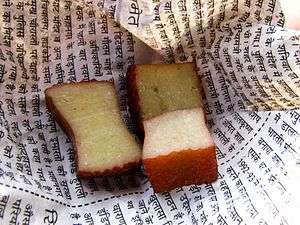List of Tibetan dishes
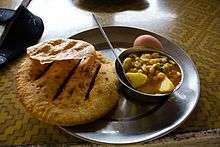
This is a list of Tibetan dishes and foods. Tibetan cuisine includes the culinary traditions and practices of Tibet and its peoples, many of whom reside in India and Nepal. It reflects the Tibetan landscape of mountains and plateaus and includes influences from neighbors (including other countries India and Nepal). It is known for its use of noodles, goat, yak, mutton, dumplings, cheese (often from yak or goat milk), butter (also from animals adapted to the Tibetan climate) and soups.
The cuisine of Tibet is quite distinct from that of its neighbors. Tibetan crops must be able grow at the high altitudes, although a few areas in Tibet are low enough to grow such crops as rice, oranges, bananas, and lemon.[1] Since only a few crops grow at such high altitudes, many features of Tibetan cuisine are imported, such as tea, rice and others.
The most important crop in Tibet is barley. Flour milled from roasted barley, called tsampa, is the staple food of Tibet. It is eaten mostly mixed with the national beverage Butter tea. Meat dishes are likely to be yak, goat, or mutton, often dried, or cooked into a spicy stew with potatoes. Many Tibetans do not eat fish[2] because fish are one of the Eight Auspicious Symbols of Buddhism.
Tibetan dishes and foods
- Chebureki – a deep-fried turnover with a filling of ground or minced meat and onions
- Cheser Mog – rice, with melted yak butter, brown sugar, raisins and salt[3]
- Chexo – a rice and yogurt dish
- Drokpa Katsa – a dish of stewed tripe, with curry, fennel, monosodium glutamate and salt[3]
- Gundain – a pastry made from barley grain and yeast (fermented into a light barley beer), with tsampa, dry curd cheese, wild ginseng, and brown sugar.[3] This pastry is often served during the Tibetan New Year and Losar as a starter.
- Gyabrag – a pancake made with barley flour, yak butter, dry cheese curds and sugar
- Gyaho – In Tibetan cuisine, Gyaho is a chafing dish in the Han Chinese style; a hot pot of vermicelli, kombu, mushrooms, meatballs, bamboo sprouts and salt. It has special significance, generally eaten by senior monks during important ceremonies.[3]
- Gyatog – noodles, much like those of the Han variety, made with eggs, flour and bone soup[3]
- Gyurma – a blood sausage made with yak or sheep's blood in Tibetan cuisine. Rice or roasted barley flour can be added as filler.
- Khapse – a biscuit that is traditionally prepared during the Tibetan/Sherpa New Year or Losar
- Khapsey – cookies or biscuits that are deep fried and usually made during celebrations such as the Losar (Tibetan New Year) or weddings
- Laping – a spicy cold mung bean noodle dish in Tibetan and Neplaese cuisine
- Lowa Khatsa – made of pieces of fried animal lung and spices[4]
- Lunggoi Katsa – stewed sheep's head with curry, fennel, monosodium glutamate and salt[3]
- Masan – a pastry made with tsampa, dry cubic or curd cheese, yak butter, brown sugar and water[3]
- Momo – a South Asian dumpling native to Tibet, Nepal, Bhutan and Sikkim
- Gong'a Momo – filled with meat paste
- Sha Momo – filled with beef or mutton
- Shoogoi Momo – prepared using mashed potato with dough, shaped into balls, with a minced meat filling, served with bread crumbs
- Sepen – hot sauce made with chillies as the primary ingredient and other spices depending on the recipe
- Sergem – made from milk once the butter from the milk is extracted. It is then put in a vessel and heated and when it is about to boil, sour liquid call "chakeu" is add and this leads to the separation of sergem from that milk
- Sha Phaley – bread stuffed with seasoned beef and cabbage
- Sha Shingbee – a stir-fry dish of sliced mutton with green beans
- Shab Tra – stir-fried meat tossed with celery, carrots and fresh green chili
- Sweet sour and spicy vegetable gravy – a soup-like vegetable curry in Tibetan cuisine that is often served with tingmo steamed bread
- Tsampa – roasted barley flour, it is a staple food
- Xab Pagri – a patty, usually baked dough, stuffed with meat paste
- Xabbatog – a dough stuffed with shredded turnips and dry curd cheese and cooked with bone soup
- Yak butter – butter made from the milk of the domesticated yak (Bos grunniens). It is a staple food item and trade item for herding communities in south Central Asia and the Tibetan Plateau.
- Yurla – a wheat pastry with butter, particularly common in Nyainrong County in northern Tibet[3]
- Droma Mogu – wild ginseng with melted yak butter and sugar[3]
- Droma sho – wild ginseng with yogurt
Beverages
- Ara – an alcoholic beverage[5] made from rice, maize, millet, or wheat, and may be either fermented or distilled.[lower-alpha 1] Circa the early 1900s, ara was frequently imported from China.[7]
- Butter tea – a drink of the people in the Himalayan regions of Nepal, Bhutan, India (particularly in Ladakh, Sikkim) and, most famously, Tibet. Traditionally, it is made from tea leaves, yak butter, water, and salt,[8] although butter made from cow's milk is increasingly used, given its wider availability and lower cost. Yak butter tea has been described as the "Tibetan national beverage."[9]
- Chhaang – a traditional Tibetan and Nepalese beer[10]
- Raksi – a traditional distilled alcoholic beverage in Tibet and Nepal.[11] It is often made at home.
Breads
- Balep – a bannock quick bread
- Balep korkun – a round and flat bread that is consumed mainly in central Tibet[12]
- Tingmo – a steamed bread
Cheeses
- Chhurpi – there are two varieties of chhurpi, a soft variety (consumed as a side dish with rice) and a hard variety (chewed like a betel nut)
- Chura kampo – made from the curds left over from boiling buttermilk, there are many possible shapes for chura kampo
- Chura loenpa – a soft cheese, similar to cottage cheese, made from the curds that are left over from boiling buttermilk
- Shosha – a pungent cheese and staple food that is often made from animals suited to the climate such as yak and goat
Desserts and sweets
- Dre-si – a sweet dish made with rice that is cooked in unsalted butter and mixed with raisins, droma (gourd shaped root found in Tibet), dates and nuts. This dish is usually served only on Losar (Tibetan new year).
- Thue – a delicacy in Tibetan cuisine made with dri cheese (or sometimes Parmesan or other hard cheeses), brown sugar (usually porang) and unsalted sweet cream butter
- Tu – a cheese cake, made with yak butter, brown sugar and water, made into a pastry.[3]
Dough foods
- Chetang Goiche – strips of dough fried with rapeseed oil, topped with brown sugar[3]
- Papza Mogu – a dough shaped into balls with melted butter, brown sugar, and dry curd cheese. It has a sweet and sour taste and is red in color.[3]
- Samkham Papleg – a dough fried in yak butter or rapeseed oil
- Sokham Bexe – fried dough with butter and minced meat
Soups and stews
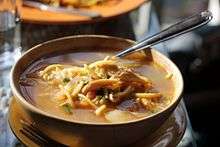
- De-Thuk – includes yak or sheep soup stock along with rice, different types of Tibetan cheeses and droma, a type of Tibetan root
- Guthuk – a noodle soup in Tibetan cuisine that is eaten two days before Losar, the Tibetan New Year[lower-alpha 2]
- Qoiri – a stew of mutton chops, made with flour, shredded wheat, chillies, dry curd cheese, water and salt
- Thenthuk – hand pulled noodle soup
- Thukpa – a noodle soup that originated in the eastern part of Tibet. Thupka has been described as a "generic Tibetan word for any soup or stew combined with noodles."[14]
- Thukpa bhatuk – a common Tibetan cuisine noodle soup that includes small bhasta noodles[15]
- Tsam-thuk – prepared with yak or sheep soup stock and tsampa (roasted barley flour) as well as a variety of Tibetan cheeses
See also
Notes
- ↑ "'Ara', a distilled liquor extracted from rice or millet is used in the colder regions of the ..."[6]
- ↑ "Guthuk is a special dish prepared for the Losar celebration. In it are dumplings that contain omens: a pebble symbolizes a long, healthy life; cayenne pepper suggests that the individual has a temperamental personality; a piece of charcoal ..."[13]
References
- ↑ "Administrative Division". Tibet Facts & Figures 2007. China Internet Information Center. 24 April 2008. Retrieved 1 November 2010.
- ↑ Cheung, S.; Wu, D.Y.H. (2014). The Globalisation of Chinese Food. Anthropology of Asia. Taylor & Francis. p. 81. ISBN 978-1-136-84739-4.
- 1 2 3 4 5 6 7 8 9 10 11 12 Li, Tao; Jiang, Hongying (2003). Tibetan Customs. 五洲传播出版社. pp. 34–37. ISBN 978-7-5085-0254-0. Retrieved 5 August 2011.
- ↑ "Foodies' delight: An epicurean walk through the lanes of Majnu Ka Teela in Delhi". Hindustan Times. November 1, 2016. Retrieved March 27, 2017.
- ↑ Langlais, R. (2012). Road News from Tibet. Springer Berlin Heidelberg. p. 289. ISBN 978-3-642-78363-0.
- ↑ Johri, S. (1962). Where India, China and Burma meet. Thacker Spink. p. 172.
- ↑ The Chinese Recorder. Presbyterian Mission Press. 1909. p. 339.
- ↑ Heiss, M.L.; Heiss, R.J. (2007). The Story of Tea: A Cultural History and Drinking Guide. Cookery, Food and Drink Series. Ten Speed Press. p. 345. ISBN 978-1-58008-745-2.
- ↑ Marcello, P.C. (2003). The Dalai Lama: A Biography. Biography Series. Greenwood Press. p. 7. ISBN 978-0-313-32207-5. Retrieved March 27, 2017.
- ↑ Boulton, C. (2013). Encyclopaedia of Brewing. EBL ebooks online. Wiley. p. pt226. ISBN 978-1-118-59813-9.
- ↑ Tamang, J.P. (2009). Himalayan Fermented Foods: Microbiology, Nutrition, and Ethnic Values. CRC Press. p. 215. ISBN 978-1-4200-9325-4.
- ↑ Burdett, A. Delicatessen Cookbook - Burdett's Delicatessen Recipes: How to make and sell Continental & World Cuisine foods. Springwood emedia. ISBN 978-1-4761-4462-7.
- ↑ Thompson, S.E. (2000). Holiday Symbols. Holiday Symbols & Customs. Omnigraphics. p. 321. ISBN 978-0-7808-0423-4.
- ↑ Boi, L.G.; Ltd, M.C.I.P. (2014). Asian Noodles. EBL-Schweitzer. Marshall Cavendish. p. 163. ISBN 978-981-4634-98-4.
- ↑ "Thukpa Bhathuk Recipe". Retrieved 8 March 2014.
External links

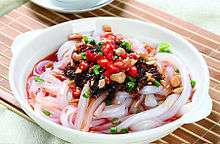

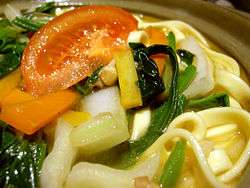
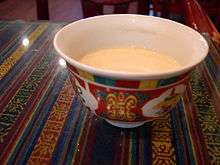
.jpg)
